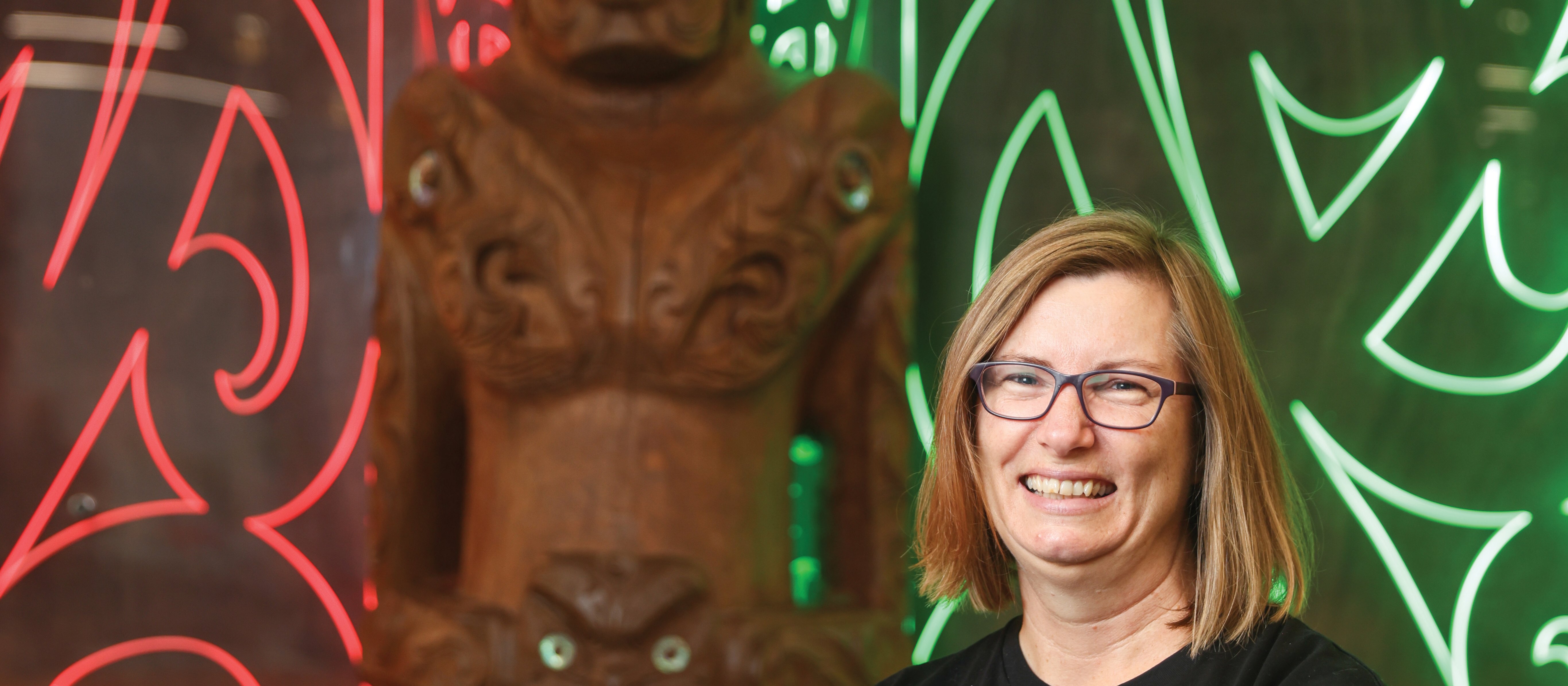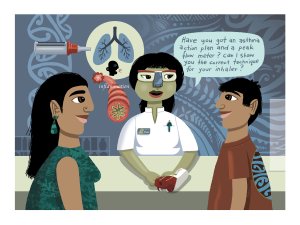Academic pharmacist Nataly Martini discusses the medical management of asthma in adults and adolescents, which has evolved to prioritise early anti-inflammatory treatment. She also explains how to improve patient outcomes by proactively identifying poor asthma control and supporting equitable access to education and treatment
Three reasons to learn te reo Māori
Three reasons to learn te reo Māori

Community pharmacist Claire Salter took part in a full-immersion Māori language course run at the University of Waikato’s Tauranga campus in 2022. She discusses her reasons for learning te reo as a Pākehā. From April, having a basic understanding of te reo Māori will be a requirement for all pharmacists under the Pharmacy Council’s competency standards
Inā kei te mōhio koe ko wai koe, i anga mai koe i hea, kei te mōhio koe kei te anga atu ki hea.
If you know who you are and where you are from, then you will know where you are going.
At its core, pharmacy practice is about people. Sometimes known as “the health professionals you see most often”, pharmacists play a vital role in ensuring the health of individuals and communities. Individuals are just that, individual, unique, and our communties are made up of a diverse mix of those from different cultural backgrounds, with different languages and beliefs.
“Culture” is not limited to ethnicity or indigeneity, but includes age, gender, sexual orientation, socioeconomic status and religious beliefs. In many communities, a dominant culture will be evident, but the presence of diversity is still undeniable.
Part of cultural competency is the process of developing skills from another culture to be better able to interact. These skills also assist us in reflecting on our own culture, identifying and addressing our inherent biases. Ultimately, this leads to cultural safety.
It is important for pharmacists to develop culturally safe practice because it helps us provide quality patient care that is respectful, responsive and relevant to the needs and preferences of our patients. Within the context of cultural safety, we are able to build trust, improving patient satisfaction and, ultimately, health outcomes. Cultural safety is a lifelong learning experience.
With all the diversity evident in our communities, where do you start to develop cultural safety? For me, a Pākehā New Zealander who grew up in a part of the country where mine was definitely the dominant culture, one of the first steps I took was to start learning te reo Māori. But why? Here are my top three reasons.
Te reo Māori is the language of this land
When the first travellers from Hawaiki landed on the shores of Aotearoa in the 1300s, they brought their language with them. As they adapted to life in a new land with a cooler climate, different geography and unique flora and fauna, their language adapted also. It slowly evolved from its original form to become te reo Māori, the Māori language.
As languages do, te reo Māori continued to evolve as the population expanded and new areas of the country were explored and inhabited. It is understood that, although many regional dialects emerged, the Māori language flourished all over the country.
I trace my own origins back to England; my forebears arrived here in the mid to late 1800s. However, I was born here. This land nurtured me as I grew up, taking full advantage of all the adventures it has to offer a Kiwi child: listening to the birds call outside my window, swimming at the local beaches, complaining through many a bush walk. For my whole life, this land, Aotearoa, has supported me, sheltered me and been my home.
This is the first reason why I choose to learn te reo Māori, to honour this land.
Te reo Māori is a gift
Fast-forward to the early 1970s. At that time, for compounding reasons, te reo Māori was being lost. It seemed like it was only a matter of time before it would be completely gone.
In 1972, the Māori Language Petition was presented on the steps of Parliament.
This is the wording of the petition:
“We, the undersigned, do humbly pray that courses in Māori language and aspects of Māori culture be offered in ALL those schools with large Māori rolls and that these same courses be offered, as a gift to the Pākehā from the Māori, in ALL other New Zealand schools as a positive effort to promote a more meaningful concept of Integration.” [emphasis my own]
Very few of the group who initiated the petition could speak the language, they were of the generation of children whose parents were beaten at school for speaking Māori, yet it was their hope that their children and grandchildren would be able to reclaim this taonga (or treasure) of Māori culture. They also had a vision beyond that, to not keep it to themselves, but to offer this taonga as a gift to non-Māori.
This is the second reason why I choose to learn te reo Māori, in appreciation of this gift, those who gave it and with the understanding of its significance.
Te reo Māori is the language of the future
Now, more than 50 years after the presentation of the petition, the tide has turned. Instead of a progressive loss of te reo Māori, there is progressive recovery. Te reo Māori is widely heard in a vast range of locations. No longer confined to the marae and formal settings, it is spoken everywhere from schools to supermarkets. Many children today are growing up with te reo Māori as their first language. A friend quipped, “One day in the not-too-distant future, it will no longer be Te Wiki o Te Reo Māori that we mark once a year, but Te Wiki o Te Reo Pākehā!”
The number of people choosing to learn and speak te reo Māori is growing steadily and I count myself among them. While we all have our own reasons for following this path, one thing is certain, whether Māori or non-Māori, our goal is the same: we all look forward to seeing te reo Māori flourish all over the country once more.
Te reo Māori has been my gateway towards cultural safety. What started as curiosity has grown into a passion, to the point where I took a year out to study full time in a full-immersion environment. The benefits have been enormous, both in terms of personal growth and in my pharmacy practice. With a deeper understanding of another culture that has come with language learning, I have been able to consider my own culture through another lens.
I feel better equipped to educate and counsel patients about their health and medications. I believe this is also beneficial to the patient, as their questions and concerns are addressed in a way that makes them feel listened to and empowered. Barriers often seem to melt away and relationships quickly form.
If you haven’t already started on your own journey towards developing culturally safe practice, where can you begin? First, take time to reflect on your own culture. What things can you identify that are the “norm” to you but may be different for others? How could this influence the way you view others who have values different from your own?
Next, consider the different cultures in your community or practice. Do you have any assumptions about certain groups in your community? With an attitude of respectful curiosity, what could you do to increase your understanding about their culture?
On the surface, engaging with cultural competency and, ultimately, cultural safety, can seem like just one more demand within a healthcare system already stretched to breaking point.
Dig a little deeper, however, and you will find that whatever you can give to developing and practising cultural safety will have exponential benefits, for the health and wellbeing of your patients as well as your own professional and personal fulfilment.
Māori Language Petition. See: tinyurl.com/Petition-tereo
Healthify Te Puna Waiora. Cultural safety & cultural competence for healthcare providers. See: tinyurl.com/Culture-competence
Curtis E, Jones R, Tipene-Leach D, et al. Why cultural safety rather than cultural competency is required to achieve health equity: a literature review and recommended definition. Int J Equity Health 2019;18:174. doi.org/10.1186/s12939-019-1082-3
Health Navigator/Health Literacy NZ. Self-management support course: Cultural safety modules 1 and 2 handout. See: tinyurl.com/Cultural-safe





